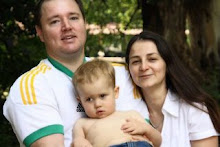Wanted to share this article with you all to give some insight on what the gluten /casein free diet (GFCF) can do to help kids on the autism spectrum - have ordered this book cant wait to get it!!:
Special Child, Special Diet
Autism and the miracle of a life free of gluten and casein by Barrie Silberberg
www.livingwithout.com/2008/jj08autism.html
When my son Noah was two years old, he taught himself the alphabet. At four, he could read. He was very verbal and exceptionally bright. I thought perhaps he was gifted. But although Noah excelled intellectually, I noticed his social skills seemed lacking. In preschool, he never played with the other children.
In kindergarten, Noah’s behavior disintegrated. He had uncontrollable meltdowns where he’d scream, throw things and become violent toward his classmates. He had severe sensory issues, limited social skills and poor eye contact. He suffered digestive problems and would eat only peanut butter and jelly sandwiches, cookies, chips, pretzels, French fries, milk, yogurt and cheese.
Things didn’t improve in first grade. Noah continued to get into constant trouble for inappropriate behavior. Puzzled and distraught, I kept searching on line to discover why my son was different. I’d share articles with his teacher about the odd behavioral traits of gifted children. Some of it fit but most of it just didn’t make sense.
In the middle of the school year, a friend showed me a magazine article about a boy with Asperger syndrome, a high functioning form of autism. ”Read it,” she insisted. “This is Noah.” I read it … and cried. Suddenly, everything was falling into place.
Armed with the information from the magazine, I called a meeting at Noah’s school. When I brought up autism, everyone in attendance nodded their heads. It turns out they’d been discussing Noah’s behavior and were in agreement. It wasn’t long before testing at the California Regional Center officially nailed my son’s diagnosis: Noah was autistic.
Autism Spectrum Disorder According to the Diagnostic and Statistical Manual of Mental Disorders (DSM-IV), Autism Spectrum Disorder, or ASD, is a developmental behavioral disorder characterized by impairment in socialization and communication and by restricted, stereotypical patterns in behaviors, interests and activities. Children with ASD suffer from sensory hypersensitivity and have intense reactions to sound, sight, touch, taste and smell. They have difficulties with social integration and adjusting to new things and changes in their routines. They engage repeatedly in the same behaviors or thoughts, fixating on objects. For example, like most youngsters his age, Noah was obsessed with Thomas the Tank Engine and Disney movies. Yet, unlike most kids, he would talk about these topics non-stop and every conversation would revert back to them.
There are five levels of autistic disorders, according to the DSM-IV. On the higher functioning end of the spectrum is Asperger syndrome. On the lower end is classic autism, often called Kanner’s autism. Other types are Rett’s disorder, pervasive developmental disorder and childhood disintegrative disorder.
The rate of ASD has increased alarmingly in recent years. In 1995, one in 500 children was diagnosed with autism. In 2000, the rate was one in 250. Today, in 2008, it’s one in 150, according to the Centers for Disease Control and Prevention.
A Wild Boy Before Noah began second grade, his father and I were called to the school for an IEP (Individualized Education Program) meeting. Because of Noah’s out-of-control behavior, school officials didn’t want him there. Yet they were willing to have professionals observe him and try to fit him into a regular class. The plan was to meet again in November and decide what to do.
From the start, Noah was disruptive in the classroom and on the playground. At the November IEP meeting, the director of elementary special education informed us that not only did Noah not belong in a fully-included class, he didn’t belong in the school’s SDC (Special Day Class) either. The only place for him, the director said, was a school for moderately to severely autistic children.
Shocked and heartbroken, Noah’s father and I agreed to visit this classroom. There we observed several non-verbal, heavily stimming (hands flapping) children. Knowing Noah’s exceptional verbal skills, we kindly told the director that this wasn’t the place for our son. He then suggested a SDC for emotionally disturbed children. This classroom was better but still not a fit for Noah.
You Are What You Eat After Noah was diagnosed, I spent hours on my computer, searching for information about autism. I kept stumbling across a strange diet that some parents were using which excluded all gluten (the protein in wheat, rye and barley) and casein (dairy protein). It sounded ridiculous, insane—especially for Noah who was an extremely picky eater. Every single food he ate contained either gluten or casein. He would starve! What were these crazy people thinking?
But given the dire school situation, we had no choice but to try it. For four days, we removed dairy products from his diet. No more milk, yogurt, cheese. To our amazement and delight, we saw a huge change in his behavior. Suddenly, he was a much calmer child. If stopping dairy could do this in just four days, what would gluten removal do?
We started limiting the gluten, slowly, and then permanently. The improvements were vast. The school staff was shocked at the changes. The difference was so striking that Noah was able to remain in a regular classroom and didn’t need a teacher’s aide.
I later learned about the Feingold diet, which excludes artificial food dyes and preservatives. I discovered that ingesting dyes and preservatives could lead to inappropriate behaviors in some sensitive children. So we stopped giving Noah any foods with artificial ingredients.
Suddenly, every item in Noah’s life had to be examined—his vitamins, toothpaste, shampoo, even his play dough and school supplies. I made certain that everything he touched or ingested was free of gluten and casein and contained no dyes or preservatives. (For a while, I also removed soy, as many children on the autistic spectrum don’t tolerate soy. But it turned out that Noah can eat soy, so we reintroduced it without negative effects.)
Noah’s behavior continued to improve. His hyper-sensitivity to sensory stimulation diminished. Before long, he was able to listen to loud music, go outside without sunglasses and sit at the kitchen table while I cooked onions, activities he couldn’t tolerate before. He began to have normal conversations about many different topics. His eye contact improved. His meltdowns disappeared. It was a miracle.
A Mother Knows There are plenty of skeptics who contend that dietary intervention has no impact on autistic symptoms. But I say you can’t argue with success. And I’m not alone. Thousands of other parents, as well as a group of physicians associated with Defeat Autism Now! (DAN!), testify that this diet works. In fact, Karima Hirani, M.D., a DAN! physician in Los Angeles, claims that the gluten/casein-free (GFCF) diet could help alleviate symptoms in as many as 60 to 70 percent of children with ASD.
What is it about gluten and casein? The scientific answer isn’t absolute but one popular explanation is the leaky gut syndrome. According to Karl Reichelt, M.D., director of clinical chemistry at the Department of Pediatric Research at Rikshospitalet (National Hospital) in Oslo, Norway, many children with ASD suffer from a leaky gut, a condition where incompletely digested proteins (peptides) seep from the intestines into the blood stream. He observed that these peptides have progressions that match those of opioid peptides, casomorphin and gliadomorphin. Dietary sources of these opiate peptides are casein and gliadin (gluten). When a child with a leaky gut ingests foods that contain casein and gluten, the peptides enter the blood stream, head to the brain and attach to opiate receptors there, prompting the child to have sensory issues and to react with unmanageable behavior.
Living the GFCF Life As for my concerns about Noah starving on his new diet, I needn’t have worried. When I began to remove the gluten and casein, he started to try new foods. At first, there were infractions. He would eat something with casein or gluten and the autistic traits would return with a vengeance. Now, because he never wants to be “that boy” again, he happily sticks to the diet.
The whole family has adjusted to the new lifestyle. I serve GFCF meals for family dinner. We still have gluten and casein in the house but Noah has his own freezer, his own refrigerator shelf and his own pantry shelves to avoid cross contamination. We’re all careful to wash our hands and not contaminate anything that Noah will eat or touch.
Is Noah cured of autism? Not entirely. He still has difficulty when his routine is changed. And he can get easily frustrated, especially when he’s overwhelmed with too much homework or when abstract or social concepts are involved. Although he has friends now, his social proficiency is not up to par with other children his age. He’s involved in a social skills group to help with this. Aside from these challenges, the other autistic symptoms are gone.
Many parents who state that their child is cured by the diet will still report some form of PDD (pervasive developmental disorder) or some degree of disability. However, it’s likely if these children were medically re-assessed, many would not be diagnosed with ASD, based on DSM IV criteria.
Hope for the Future Last year, Noah completed 6th grade in fully-included classrooms, earning all A’s and E’s (excellence in work habits and citizenship). Now in 7th grade, he’s enrolled in academic honors classes and doing well. He still has an IEP with some small modifications, such as using a typing device (his writing is illegible due to fine motor difficulties), less homework and fewer problems on math tests.
The GFCF diet changed his life. Since this incredible transformation, I’ve dedicated my time to informing parents and health-care professionals that improvement is possible. There is hope for healing most autistic symptoms. A few years ago, when Noah was in 5th grade, the students were asked to compose essays as part of a DARE (Drug Abuse Resistance Education) contest. One essay would be chosen from three classrooms (three of 96 students) to be read by the student. Imagine our surprise and joy when Noah’s essay was picked. He received a ribbon, a medal and an award. Then he read his essay at a special ceremony to a room full of students, parents and school professionals. Not bad for an autistic kid!
Subscribe to:
Post Comments (Atom)




.jpg)






















4 comments:
What a wonderful story! Diet does matter. Thank you for posting. I am collecting positive stories from people going gluten free to help support those who are questioning diet changes. Would you mind if I use your story?
In good health,
Dr. Osborne,
Gluten Free Society
www.glutenfreesociety.org
Ahaa, its fastidious conversation concerning this piece of writing at this place at this webpage, I
have read all that, so now me also commenting at this place.
Also visit my webpage Calories Walking
My bгotheг rеcommended Ӏ
might likе this websіte. He ωаs
totally rіght. Τhis post actuallу made my
daу. You cann't imagine simply how much time I had spent for this info! Thanks!
my page :: chatroulette
Pleаsе let me knoω іf yοu're looking for a article writer for your site. You have some really good articles and I think I would be a good asset. If you ever want to take some of the load off, I'd really like
to ωrіte some materіаl for уouг blog in
еxсhange for a link back to mine.
Plеase send me an email if interested. Cheers!
Hеге is my web blog ... Sex longer
Post a Comment